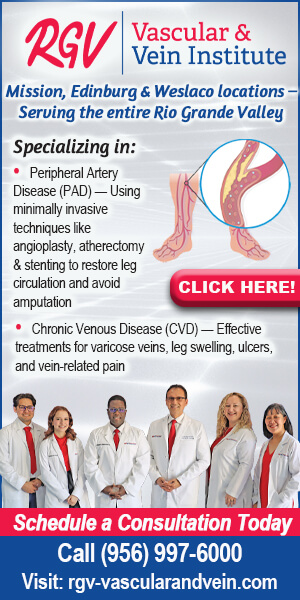
Mega Doctor News
Brownsville – There is now new treatment available at Valley Baptist Medical Center-Brownsville for a select number of patients suffering from narrowing or clogged arteries in the legs caused by peripheral artery disease, in which a cardiologist will access a blockage via a blood vessel in the foot rather than a vessel in the groin.
Peripheral artery disease is described by the American Heart Association as most commonly the narrowing of the arteries in the legs caused by the buildup of plaque along the arterial walls. That buildup can eventually lead to a complete blockage, which in turn causes loss of circulation to the extremities. If left untreated, amputation of the affected extremity is often the result. Risk factors for peripheral artery disease include smoking, high cholesterol and blood pressure, and diabetes.
Because diabetes is so prevalent in the Rio Grande Valley, Dr. Fadi Alfayoumi, Medical Director of Cardiology at Valley Baptist Medical Center-Brownsville, said many of his patients suffer from some form of peripheral artery disease. According to the Centers for Disease Control and Prevention, approximately 8.5 million people in the United States have PAD, including 12-to-20 percent of individuals older than age 60.
For most of those patients, the common course of treatment is for a cardiologist to perform a procedure in which a catheter is threaded through a vessel in the groin to the blockage site in the leg. Once the blockage is reached, a small balloon is inflated, pushing the plaque against the walls of the artery to restore blood flow. In some cases, a stent may be utilized to keep the artery open following the procedure.
In a few cases, however, the anatomy of a patient or the location of the blockage will prevent cardiologists from accessing the site from the groin. “The conventional way of performing the procedure is by accessing the area through the groin and traveling down the leg and following the path of the blood stream,” Alfayoumi said. “But occasionally the anatomy is not favorable and we have certain issues we notice during imaging that tell us that our likelihood of success in using that method will be low.”
Alfayoumi encountered one such patient in February, leading to the first procedure at Valley Baptist Medical Center-Brownsville through which a blockage in the leg was accessed via an artery in the foot.
Alfayoumi went on to describe the procedure, which was performed in the Cardiac Catheterization Lab at Valley Baptist-Brownsville. “We accessed the blood vessel called the posterior tibial artery just above the ankle. Once we entered through that vessel, we used specific equipment to facilitate the passing of the wires to the blockage and we opened it,” he said.
While this new method is not an option for all patients suffering from peripheral artery disease, Alfayoumi said it does provide an alternative for a select number of patients who would not experience positive outcomes through the traditional procedure of gaining access to blockages via vessels in the groin.
“In select cases when the patient has an advanced below the knee disease, the surgical outcomes may be good immediately, but long term outcomes were problematic,” he said. “In a few cases the patient may come back in three months with the same problem, and now we’re back at the same point.”
In addition to providing additional alternatives to patients suffering from peripheral artery disease, complications associated with accessing blockages “from below” rather than via vessels in the groin can be reduced. Patients undergoing procedures that include a physician gaining access via vessels in the groin will often lay down from four-to-six-hours during recovery as they are monitored closely for post-procedure bleeding. When access is gained to the blocked area from below, a patient can begin moving in about an hour and may be able to go home shortly thereafter. The procedure itself takes approximately 20 minutes.
“This is going to create hope for select patients, and this is so exciting for me as a physician,” Alfayoumi said. “We’re looking forward to helping the patients that we may have been unable to help in the past and giving them an alternative solution to their serious health issues.”
In addition to this procedure, Valley Baptist Health System offers comprehensive heart care from diagnosis to rehabilitation. Cardiovascular specialists at Valley Baptist can diagnose heart conditions through a variety of procedures including: Cardiac ultrasound, cardiac and vascular screening, cardiac stress testing, electrocardiogram (EKG) testing, and vascular ultrasound.
Once a patient’s condition has been diagnosed, cardiovascular specialists can choose the appropriate course of care ranging from utilization of Valley Baptists cardiac catheterization labs to open heart surgery.









